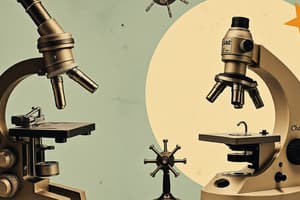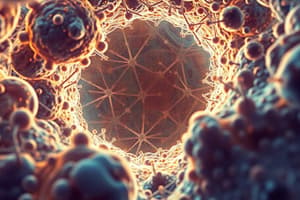Podcast
Questions and Answers
What is the main function of the nucleus in a eukaryotic cell?
What is the main function of the nucleus in a eukaryotic cell?
- Cytoplasmic protein synthesis
- Site of RNA synthesis
- Contains most of the cell's genes (correct)
- Maintenance of cell shape
Which cellular component is responsible for protein synthesis?
Which cellular component is responsible for protein synthesis?
- Mitochondria
- Endoplasmic reticulum
- Golgi apparatus
- Ribosomes (correct)
How are free ribosomes different from bound ribosomes in a cell?
How are free ribosomes different from bound ribosomes in a cell?
- Bound ribosomes are involved in protein synthesis, while free ribosomes are not
- Bound ribosomes produce proteins for the nucleus, while free ribosomes produce membrane proteins
- Free ribosomes are attached to the endoplasmic reticulum, while bound ribosomes are in the cytosol
- Free ribosomes make proteins that function outside the cell, while bound ribosomes make cytosolic proteins (correct)
What is the main function of chromatin in a cell preparing to divide?
What is the main function of chromatin in a cell preparing to divide?
What distinguishes prokaryotic cells from eukaryotic cells?
What distinguishes prokaryotic cells from eukaryotic cells?
In which cellular region are most proteins made by free ribosomes functional?
In which cellular region are most proteins made by free ribosomes functional?
What is the main difference between a light microscope and an electron microscope?
What is the main difference between a light microscope and an electron microscope?
Which unit of measure is most suitable for measuring the diameter of a mitochondrion?
Which unit of measure is most suitable for measuring the diameter of a mitochondrion?
What is the purpose of using fluorescence microscopy in studying cells?
What is the purpose of using fluorescence microscopy in studying cells?
Why is surface area to volume ratio important for cells?
Why is surface area to volume ratio important for cells?
What is the significance of the Cell Theory?
What is the significance of the Cell Theory?
Which organelle has a diameter in the nanometer range?
Which organelle has a diameter in the nanometer range?
Flashcards
What is the nucleus?
What is the nucleus?
The nucleus is the control center of the eukaryotic cell, responsible for storing and protecting genetic information in the form of DNA.
Where are proteins made?
Where are proteins made?
Ribosomes are responsible for protein synthesis, creating proteins from instructions in the DNA.
What's the difference between free and bound ribosomes?
What's the difference between free and bound ribosomes?
Free ribosomes are located in the cytosol and produce proteins that function within the cell. Bound ribosomes are attached to the endoplasmic reticulum (ER) and synthesize proteins that are destined for export outside the cell or for insertion into membranes.
What is chromatin?
What is chromatin?
Signup and view all the flashcards
How do prokaryotes differ from eukaryotes?
How do prokaryotes differ from eukaryotes?
Signup and view all the flashcards
Where do proteins made by free ribosomes function?
Where do proteins made by free ribosomes function?
Signup and view all the flashcards
What's the difference between light and electron microscopes?
What's the difference between light and electron microscopes?
Signup and view all the flashcards
How big is a mitochondrion?
How big is a mitochondrion?
Signup and view all the flashcards
What is fluorescence microscopy?
What is fluorescence microscopy?
Signup and view all the flashcards
How does surface area to volume ratio affect cells?
How does surface area to volume ratio affect cells?
Signup and view all the flashcards
What is the Cell Theory?
What is the Cell Theory?
Signup and view all the flashcards
Are ribosomes big or small?
Are ribosomes big or small?
Signup and view all the flashcards
Study Notes
Nucleus Function
- The nucleus is the control center of the eukaryotic cell, responsible for storing and protecting genetic information in the form of DNA.
Protein Synthesis Location
- Ribosomes are responsible for protein synthesis.
Free vs. Bound Ribosomes
- Free ribosomes are located in the cytosol and produce proteins that function within the cell.
- Bound ribosomes are attached to the endoplasmic reticulum (ER) and synthesize proteins that are destined for export outside the cell or for insertion into membranes.
Chromatin Function
- Chromatin condenses into chromosomes during cell division to ensure the equal distribution of genetic material to daughter cells.
Prokaryotic vs. Eukaryotic Cells
- Prokaryotic cells lack a nucleus and other membrane-bound organelles, while eukaryotic cells have a nucleus and a complex system of internal membranes.
- Prokaryotic cells are generally smaller and simpler than eukaryotic cells.
Location of Free Ribosome Products
- Proteins made by free ribosomes are primarily functional in the cytosol.
Light vs. Electron Microscopy
- Light microscopes use visible light to illuminate and magnify specimens, while electron microscopes use a beam of electrons to generate images.
- Electron microscopes provide much higher resolution than light microscopes, allowing for the visualization of smaller cellular structures.
Unit of Measure for Mitochondria
- The diameter of a mitochondrion is typically measured in micrometers (µm).
Fluorescence Microscopy
- Fluorescence microscopy uses fluorescent dyes to label specific cellular components, allowing for their visualization and localization within the cell.
Surface Area to Volume Ratio
- The surface area to volume ratio affects the efficiency of nutrient uptake and waste removal for cells.
- As a cell increases in size, its volume grows faster than its surface area, leading to a decrease in the ratio. This can limit the cell's ability to exchange materials with its environment.
Significance of Cell Theory
- The Cell Theory is a fundamental principle in biology that states:
- All living organisms are composed of one or more cells.
- The cell is the basic unit of structure and function in living organisms.
- All cells arise from pre-existing cells.
- The Cell Theory has revolutionized our understanding of life and has served as the foundation for many biological discoveries.
Nanometer Range Organelle
- Ribosomes are organelles with a diameter in the nanometer range.
Studying That Suits You
Use AI to generate personalized quizzes and flashcards to suit your learning preferences.




